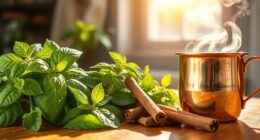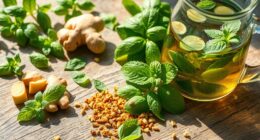As we explore the world of natural remedies, we're drawn to seven herbs on the herbology menu that have been used for centuries to address some of humanity's most pressing health concerns. From Calendula's soothing skin solutions to Turmeric's golden anti-inflammatory power, these herbs offer a range of benefits. Peppermint provides cooling digestive relief, while Ginger's warming properties stimulate circulation and aid digestion. Sage enhances cognitive function, and Echinacea boosts our immune system. By delving into these natural wonders, we may reveal the secrets to accessing nature's medicine cabinet and discover even more ways to nurture our bodies and minds.
Key Takeaways
• The Herbology Menu features 7 herbs, including Echinacea, Ginger, Turmeric, Peppermint, and Garlic, each with unique health benefits.
• Calendula and Turmeric are effective for skin health, with anti-inflammatory and antimicrobial properties for conditions like eczema and dermatitis.
• Peppermint and Ginger support digestive health, providing relief from digestive discomfort and nausea.
• Sage enhances cognitive function, improving memory, attention, and cognitive performance with its antioxidant and anti-inflammatory properties.
• Echinacea is an immune system defender, reducing the severity and duration of colds and flu.
Calendula's Soothing Skin Solutions
When we're faced with skin irritations, we often reach for harsh chemical-laden products, but we're better off turning to calendula, a natural and gentle herb that's been soothing skin for centuries.
This versatile herb, also known as marigold, possesses anti-inflammatory, antimicrobial, and antifungal properties, making it ideal for treating wounds, cuts, and skin irritations. We can find calendula in herbal skincare products like creams, ointments, and salves, which promote skin healing and reduce inflammation.
It's particularly effective in addressing conditions like eczema, dermatitis, and minor burns, providing a gentle and effective natural remedy. The vibrant orange and yellow flowers of the calendula plant contain beneficial compounds that contribute to its skin-soothing effects.
Turmeric's Golden Anti-Inflammatory Power

How can we harness the potent anti-inflammatory properties of turmeric to alleviate inflammation and promote overall well-being?
For centuries, turmeric has been used in traditional medicine to treat various ailments, and for good reason. The compound curcumin, found in turmeric, is renowned for its powerful anti-inflammatory properties. Studies have shown that turmeric can help reduce inflammation, making it a potential natural remedy for conditions like arthritis.
We can reap the benefits of turmeric by incorporating it into our daily diet. Not only can it help support a healthy immune system, but it can also promote overall well-being. To maximize the effects of curcumin, we can consume turmeric with black pepper or take it in supplement form, which enhances its bioavailability.
Peppermint's Cooling Digestive Relief

As we seek natural remedies to calm our digestive systems, peppermint's cooling properties offer a revitalizing solution to soothe our stomachs.
We've all experienced the discomfort of indigestion and bloating, but peppermint's menthol content relaxes the muscles in our digestive tract, easing discomfort and promoting healthy digestion.
A warm cup of peppermint tea is a popular and effective way to consume this herb for digestive relief. But that's not all – studies have shown that peppermint oil capsules can greatly reduce symptoms of irritable bowel syndrome (IBS).
The benefits of peppermint extend beyond digestive issues, too. It can freshen our breath and even provide a natural remedy for headaches and sinus congestion.
Whether we're looking to alleviate digestive discomfort or simply enjoy a revitalizing pick-me-up, peppermint is a natural solution worth considering.
Ginger's Warming Circulatory Boost

As we explore Ginger's Warming Circulatory Boost, we're excited to discover the benefits of this root herb on our overall health.
We'll examine how ginger stimulates circulation, which can lead to improved cardiovascular health and relief from cold extremities.
Circulation Stimulation Benefits
Ginger's natural warming properties make it an excellent circulation stimulator, helping us to overcome cold hands and feet by promoting healthy blood flow. By incorporating ginger into our diet or as a tea, we can boost circulation and improve overall blood circulation.
This, in turn, can enhance cardiovascular health by supporting proper blood flow and reducing inflammation. Moreover, the circulatory stimulation from ginger can help alleviate symptoms of poor circulation, such as numbness or tingling in extremities.
We can reap these benefits by making ginger a regular part of our routine. Whether we add it to our meals or enjoy it as a warm, soothing tea, ginger's warming properties can help stimulate our circulation and promote overall well-being.
Warming Digestive Relief
By incorporating ginger into our daily routine, we can harness its natural warming properties to bring soothing relief to digestive discomfort. This ancient spice has been traditionally used to aid digestion and boost circulation, thanks to its active compound, gingerol. As an anti-inflammatory and antioxidant, gingerol helps alleviate symptoms of indigestion, nausea, and bloating.
We can add fresh ginger to our meals or drink ginger tea to reap its benefits. Ginger's warming properties also make it a common ingredient in herbal remedies for colds and flu, as it helps to boost our immune system. By making ginger a part of our daily routine, we can experience the comforting relief it brings to our digestive system.
Whether we're dealing with occasional digestive discomfort or chronic issues, ginger's natural warming properties can provide a sense of comfort and well-being. By embracing this natural remedy, we can take the first step towards a healthier, happier gut.
Sage's Cognitive Function Enhancer

With our increasingly demanding lifestyles, we're constantly seeking ways to stay mentally sharp and focused, which is where sage's cognitive function enhancer comes into play. As an herb rich in antioxidants and anti-inflammatory compounds, sage has been shown to improve memory, attention, and cognitive performance. The active compounds in sage, such as rosmarinic acid and carnosic acid, help protect the brain from oxidative stress and inflammation, supporting overall brain health.
Here's a breakdown of sage's cognitive benefits:
| Benefit | Description | Effect |
|---|---|---|
| Improved Memory | Enhances memory recall and retention | Better learning and retention |
| Enhanced Focus | Increases attention and concentration | Improved mental clarity |
| Cognitive Performance | Boosts processing speed and accuracy | Faster and more accurate decision-making |
| Brain Health | Supports overall brain health and function | Reduced risk of cognitive decline |
| Antioxidant Properties | Neutralizes free radicals and oxidative stress | Protection against cell damage |
Chamomile's Calming Sleep Inducer

As we explore the calming properties of chamomile, we'll examine how it can soothe insomnia symptoms naturally and reduce anxiety's grip on our minds.
We'll look at how this herb's calming effects can quiet the racing thoughts that keep us awake, promoting a restful night's sleep.
Soothing Insomnia Symptoms Naturally
We've all been there – lying awake at night, our minds racing with stress and anxiety, making it impossible to drift off to sleep. Insomnia can be a frustrating and debilitating experience, affecting our mood, energy levels, and overall well-being.
Fortunately, nature has provided us with a gentle and effective solution: chamomile. This herb has been used for centuries to soothe insomnia symptoms naturally, promoting relaxation and calming our minds and bodies.
Chamomile tea can be consumed before bedtime to reduce stress and anxiety, making it easier to fall asleep.
The apigenin compound in chamomile binds to specific receptors in the brain, initiating sleep and reducing insomnia symptoms.
Studies have consistently shown that chamomile improves sleep patterns, making it an effective natural remedy for insomnia.
Calming Effects on Anxiety
By incorporating chamomile into our daily routine, we can harness its calming effects to reduce anxiety and set ourselves up for a restful night's sleep. This herb has been shown to interact with neurotransmitters in the brain, reducing symptoms of anxiety and promoting relaxation.
One of the easiest ways to reap the benefits of chamomile is by drinking chamomile tea, a soothing and gentle way to unwind after a long day. The compounds found in chamomile, such as apigenin, have been linked to reducing anxiety and improving overall mental well-being.
By incorporating chamomile as a natural sleep inducer, we can improve the quality of our sleep and reduce stress levels. This is especially important in today's fast-paced world, where anxiety and insomnia are all too common.
Echinacea's Immune System Defender

When we're feeling under the weather, our bodies are crying out for a potent immune system defender, and echinacea is one of the most reliable heroes we can call upon. As a popular herb known for its immune-boosting properties, echinacea stimulates our body's defense mechanisms, helping us fight off infections.
We often reach for it to reduce the severity and duration of colds and flu, and research suggests it may even help prevent respiratory infections.
Here's what we love about echinacea:
- It's available in various forms, from soothing teas to convenient supplements, making it easy to incorporate into our daily routine.
- Echinacea's immune-boosting properties make it a great natural remedy for when we're feeling under the weather.
- It's been shown to reduce the severity and duration of cold and flu symptoms.
- Research suggests it may even help prevent respiratory infections, giving us an added layer of protection against seasonal illnesses.
Frequently Asked Questions
Can You Give Me a List of Herbs?
We're happy to provide you with a list of herbs!
There's thyme, oregano, rosemary, ginger, raspberry leaf, nettle, chamomile, clove, and cayenne pepper – all of which offer unique health benefits.
These popular herbs have been used for centuries in traditional medicine and can be incorporated into your diet to enhance healing and therapeutic benefits.
We're excited to explore the possibilities with you!
What Herbs Can Be Used as Medicine?
We're curious about which herbs can be used as medicine, and the good news is that many can! Herbs like thyme, oregano, and rosemary are packed with potent medicinal properties that can be easily incorporated into our daily meals.
Others, such as ginger, nettle, and chamomile, offer unique benefits for specific health conditions. By tapping into these herbs in our cooking, we can harness their therapeutic potential and transform our food into natural remedies.
How Do I Become a Holistic Apothecary?
We're excited to explore the world of holistic apothecary!
To become a holistic apothecary, we'll need to study the medicinal properties of herbs and plants, understanding how they interact and combine for maximum health benefits.
We'll also learn various preparation methods, like teas and tinctures, and cultivate a deep connection with nature's healing powers.
How Many Herbs Exist?
We've always wondered, how many herbs exist? The truth is, there are over 20,000 species of herbs used for medicinal and culinary purposes worldwide!
That's a staggering number, and it's no wonder people are turning to herbal medicine for natural solutions. From basil to oregano, each herb has unique properties that can promote health and wellness.
It's no surprise herbal medicine is gaining popularity as people seek alternatives to conventional medicine.
Conclusion
As we explore the world of herbology, we uncover the remarkable potential of these 7 herbs to transform our health. From Calendula's skin-soothing properties to Echinacea's immune-boosting powers, each herb offers a unique solution to common ailments.
But what's most fascinating is the ancient wisdom behind these natural remedies. Did ancient civilizations stumble upon these herbal remedies by chance, or was it a result of careful observation and experimentation? The truth lies in the intricate web of trial and error, passed down through generations, waiting to be unraveled.










